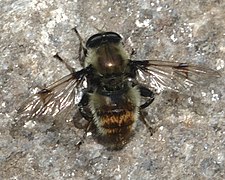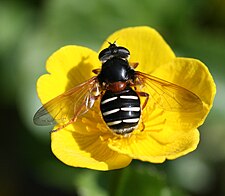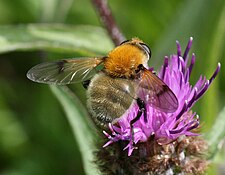Sericomyia
| Sericomyia | |
|---|---|

| |
| Male Sericomyia silentis | |
| Scientific classification | |
| Domain: | Eukaryota |
| Kingdom: | Animalia |
| Phylum: | Arthropoda |
| Class: | Insecta |
| Order: | Diptera |
| Family: | Syrphidae |
| Genus: | Sericomyia Meigen, 1803 |
| Synonyms | |
| |
Sercomyia are large flies with species that are bee mimics both short pile and long pile. Sericomyiine flower flies are common in boreal forests across the Holarctic region and southward at higher elevations into the Oriental and Neotropical regions.[1] Sericomyia species have larvae of the rat-tailed maggot type, often found in ponds rich in decomposing vegetation where they filter out microorganisms as their food [2][3][4]
Description

They have an oval flagellum with a plumose arista. The eye are bare and narrowly to broadly holoptic in male. The wings are darkly colored along the anterior margin. Cell r1 is open. The stigmatic crossvein is absent. The cell r4+5 with long petiole, longer than humeral crossvein. The vein R4+5 is straight to moderately sinuate.[5]


Species
|
Subgenus: Sericomyia
|
Subgenus: Arctophila
|
Subgenus: Conosyrphus
|
Gallery
-
Sericomyia chrysotoxoides female
-
Sericomyia flagrans male
-
Sericomyia lappona female
-
Sericomyia militaris female
-
Sericomyia silentis female
-
Sericomyia superbiens female
References
- ^ "Sercomyia ". GBIF. Retrieved 2020-07-28.
- ^ Rotheray, G.E. (1993). "Colour Guide to Hoverfly Larvae (Diptera, Syrphidae) in Britain and Europe" (PDF). Diperists Digest. 9: 155.
- ^ Van Veen, M.P. (2004). Hoverflies of Northwest Europe, Identification Keys to the Syrphidae (Hardback). Utrecht: KNNV Publishing. p. 254. ISBN 90-5011-199-8.
- ^ Stubbs, Alan E. & Falk, Steven J. (1983). British Hoverflies: An Illustrated Identification Guide. British Entomological & Natural History Society. p. 253, xvpp.
- ^ Skevington, J. H.; Thompson, F. C. (2012). "Review of New World Sericomyia (Diptera: Syrphidae), including description of a new species" (PDF). The Canadian Entomologist. 144 (2): 216–247. doi:10.4039/tce.2012.24.
- ^ Williston, S.W. (1887). "Synopsis of the North American Syrphidae". Bulletin of the United States National Museum. 31: 1–335.
- ^ a b Barkalov, A.V. "Syrphidae collection of Siberian Zoological Museum". Novosibirsk, Russia: the Institute of Animal Systematics and Ecology, Siberian Branch of the Russian Academy of Sciences. Archived from the original on October 20, 2008. Retrieved 17 August 2009.
- ^ Coquillett, D.W. (1907). "NEW GENERA AND SPECIES OF DIPTERA". The Canadian Entomologist. 39 (3): 75–76. doi:10.4039/Ent3975-3.
- ^ Curran, Charles Howard (1934). "Notes on the Syrphidae in the Slosson Collection of Diptera" (PDF). Amer. Mus. Nat. Hist., Amer. Mus. Novitates. 724: 1–7.
- ^ Osburn, Raymond (1926). "A New Species of the Genus Condidea". Entomological News. 37: 51.






